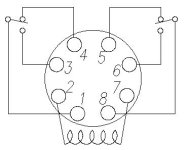Hello all,
My customer wants me to monitor a 120VAC power source for failure. For this I am using a 120VAC relay (by Magnecraft). I want to take the contacts from this 120VAC relay to an Allen-Bradley digital input card, p/n 1756-IB16I.
Can I do this without damaging the digital input card? Do I NEED to use a 120VAC Allen-Bradley input card?
Perhaps I could use an interposing 24VDC relay between the 120VAC relay and the 24VDC input card?
Any thoughts on this?
My customer wants me to monitor a 120VAC power source for failure. For this I am using a 120VAC relay (by Magnecraft). I want to take the contacts from this 120VAC relay to an Allen-Bradley digital input card, p/n 1756-IB16I.
Can I do this without damaging the digital input card? Do I NEED to use a 120VAC Allen-Bradley input card?
Perhaps I could use an interposing 24VDC relay between the 120VAC relay and the 24VDC input card?
Any thoughts on this?





